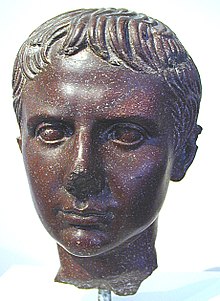4
Appearance
| Millennium: | 1st millennium |
|---|---|
| Centuries: | 1st century BC – 1st century – 2nd century |
| Decades: | 20s BC 10s BC 0s BC – 0s – 10s 20s 30s |
| Years: | AD 1 AD 2 AD 3 – AD 4 – AD 5 AD 6 AD 7 |
| Gregorian calendar | AD 4 IV |
| Ab urbe condita | 757 |
| Assyrian calendar | 4754 |
| Balinese saka calendar | N/A |
| Bengali calendar | −589 |
| Berber calendar | 954 |
| Buddhist calendar | 548 |
| Burmese calendar | −634 |
| Byzantine calendar | 5512–5513 |
| Chinese calendar | 癸亥年 (Water Pig) 2700 or 2640 — to — 甲子年 (Wood Rat) 2701 or 2641 |
| Coptic calendar | −280 – −279 |
| Discordian calendar | 1170 |
| Ethiopian calendar | −4 – −3 |
| Hebrew calendar | 3764–3765 |
| Hindu calendars | |
| - Vikram Samvat | 60–61 |
| - Shaka Samvat | N/A |
| - Kali Yuga | 3104–3105 |
| Holocene calendar | 10004 |
| Iranian calendar | 618 BP – 617 BP |
| Islamic calendar | 637 BH – 636 BH |
| Javanese calendar | N/A |
| Julian calendar | AD 4 IV |
| Korean calendar | 2337 |
| Minguo calendar | 1908 before ROC 民前1908年 |
| Nanakshahi calendar | −1464 |
| Seleucid era | 315/316 AG |
| Thai solar calendar | 546–547 |
| Tibetan calendar | 阴水猪年 (female Water-Pig) 130 or −251 or −1023 — to — 阳木鼠年 (male Wood-Rat) 131 or −250 or −1022 |
The year 4 (IV) was a leap year which started on a Tuesday, according to the Julian calendar.[1] According to the Gregorian calendar, it started on a Thursday.[2] At the time, it was known as the Year of the Consulship of Catus and Saturninus. It was called the fourth year since the early medieval period, when the Anno Domini calendar era became the usual method in Europe for naming years. It was the 4th year of the 1st century.
Events
[change | change source]By place
[change | change source]Roman Empire
[change | change source]- Emperor Caesar Augustus summons Tiberius to Rome, and names him his heir and future emperor. At the same time, Agrippa Postumus the last son of Marcus Vipsanius Agrippa is also adopted and named as Augustus' heir.
- Tiberius also adopts Germanicus as his own heir.
- Sextus Aelius Catus becomes consul.
- The Lex Aelia Sentia regulates the manumission of slaves.
- Signature of a pact of non-aggression and friendship between the Roman Empire, represented by Tiberius, and the German tribe the Cherusci, represented by their King Segimer. Arminius and Flavus, sons of Segimer, were brought into the Roman army as the Leaders of the auxiliary troops.
- Julia the Elder returns from exile to live in Rhegium in disgrace.
- Augustus Pardons Gnaeus Cornelius Cinna Magnus along with Aemilia Lepida, the daughter of Marcus Aemilius Lepidus for alleged involvement in a conspiracy against the emperor.
- Marcus Plautius Silvanus is appointed proconsul of Asia.
- Polianus Maradonius becomes Archon of Athens
Mid-East
[change | change source]- King Phraataces and Queen Musa of Parthia are overthrown and killed, the crown being offered to Orodes III of Parthia – the beginning of the interregnum
Asia
[change | change source]- Namhae Chachaung succeeds Bak Hyeokgeose as king of the Korean kingdom of Silla (traditional date)
- Emperor Ping of Han marries Empress Wang (Ping) daughter of Wang Mang cementing his influence.
By topic
[change | change source]Arts and sciences
[change | change source]- Nicholas of Damascus writes the 14 volume History of the World.
Births
[change | change source]- Columella, Roman writer (d. 70)
- Daemusin of Goguryeo, king of Goguryeo (d. 44)
Deaths
[change | change source]
- Gaius Caesar, son of Marcus Vipsanius Agrippa and Julia the Elder, dies from wounds suffered during a campaign in Artagira, Armenia.[3]
- Bak Hyeokgeose of Silla, first ruler of Korea.
- Gaius Asinius Pollio, Roman emperor, poet and historian (b. 65 BC).[4]
- Terentia, first wife of Marcus Tullius Cicero (b. 98 BC).
- Ariobarzanes II, King of Media Atropatane (b. 40 BC).
- Artavasdas IV, King of Armenia (b. 20 BC).
References
[change | change source]- ↑ "CalendarHome.com - 4". calendarhome.com. 2011. Retrieved August 4, 2011.
- ↑ "year 4 - Wolfram|Alpha". wolframalpha.com. 2011. Retrieved August 4, 2011.
- ↑ Mommsen, Theodor; Demandt, Barbara; Wiedemann, Thomas E.J.; Demandt, Alexander (1996). A History of Rome Under the Emperors. Psychology Press. p. 107. ISBN 978-0-415-10113-4.
- ↑ Jerome (Chronicon 2020) says he died in AD 4 in the seventieth year of his life, which would place the year of his birth at 65 BC.
